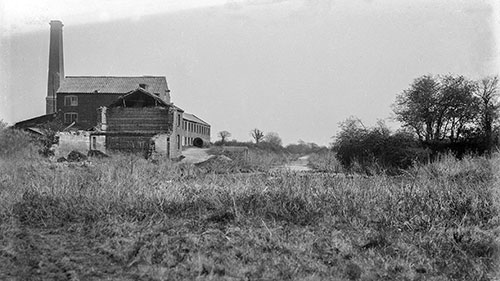 |
|
19th April 1914
|
|
Antingham Bone Mill
- Lower River Ant / North Walsham & Dilham Canal |
 |
|
19th April 1914
|
|
Antingham unsually
had two watermills within a couple of hundred yards of each other - |
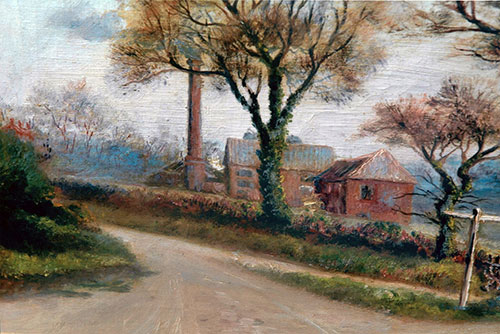 |
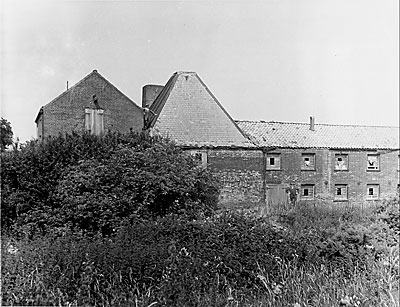 |
|
Painting - c.1910
|
c.1946 |
|
The lower and
larger mill was built on the canal that opened in 1826. The mill was built
of brick with a slate roof, it was 65 yards long and two storeys high, standing on a site of 1 acre, 3 roods.. |
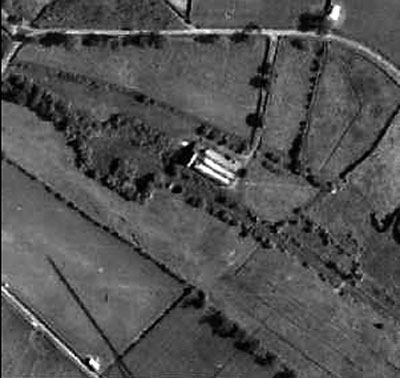 |
|
1946 |
|
Contents of the Upper Mill as listed in Schedule 1 of the 1847 Lease Agreement |
| Water and pit wheels Floodgates Two nut wheels One pair of cutters with machinery in wooden frames One pair of cutters with machinery in wooden frames and screen Dodman or screw pump One large and one small boiler with furnaces |
|
Indemnity and insurance at Norwich Union. |
|
The 1847 Lease mentions the right to burn bricks on the land forming Bradfield Hall Farm on Plot No. 2 on the Map of Indenture. |
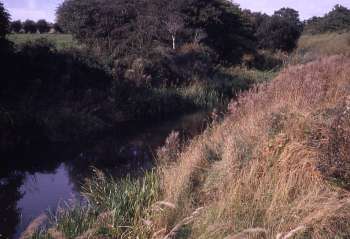 |
|
The
mill site October 1967
|
I set off to the mill that grinds bones with a cart full. |
The census of 1861 records John Hall of Bradfield as being a bone miller but by the census of 1871 he had changed jobs and was recorded as an agricultural labourer. |
|
Men were busy
in the mills from January until the end of May, sometimes working until
midnight. They then maintained the mill and went on to work on local farms. |
|
According to
one Michael Dixon, whose father knew the mill between 1913 and 1915, the
mill at that time was a single brick building with a leanto extension.
There was an office within the main building and the leanto housed a portable
coal fired engine that used its own chimney rather than a brick built
one. |
In the early days the mill was water driven but in later years a Crossley gas engine was used that was fired by anthracite and coke, some of which was apparently made on the premises. James Swan was the last foreman engineer in charge and he had been preceded by a Mr. Mobbs. A Mr. Dunning was another of the four or five workers at the time and a Mr. Hurn drove a lorry for the mill during the war. |
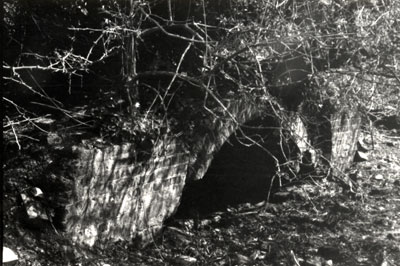 |
|
Wheel arch c.1979 |
Vitrol was carted from North Walsham station to the mill where there was large tank and a monkey was used to mix up the artificial manure. |
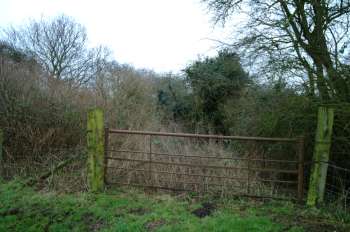 |
|
Part
of the mill site 12th January 2003
|
|
The North Walsham & Dilham Canal |
This was the
only official canal in Norfolk and was really the canalisation of the River
Ant. It was made wider than most other canals in order to accommodate Norfolk
wherries. The main cargoes were offal to the two Antingham Bone mills with
return loads of fertiliser. Corn and flour moved in and out of Bacton_Wood and Swafield mills with other commodities
such as timber, farm produce and coal making up the majority of the remainder
of trade. It was hoped that coal would be the mainstay cargo but this never
materialised. The canal was just over 8¾ miles long, ran from Smallburgh
to Antingham and contained 6 locks: Honing, Briggate
mill, Ebridge mill, Bacton
Wood mill, Swafield lower and Swafield
Upper. 1812: Act of Parliament passed authorising construction of the canal 29th August 1826: Canal opened to Antingham having cost £32,000 to build 1885: Ailing canal sold for £600 but the company's London solicitor absconded with the money 1886: Scheme introduced to encourage tourist traffic c.1893: Antingham - Swafield section abandoned because of lack of traffic 1934: The wherry Ella, sailed from Bacton Wood Staithe for the last time 2003: Canal navigable for the first 2 miles as far as Honing Lock |
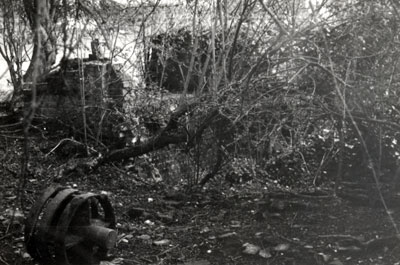 |
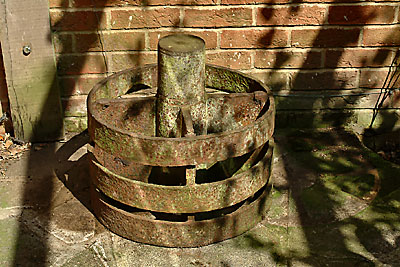 |
|
Wheel gudgeon - axle end c.1979 |
Wheel gudgeon - axle end 10th August 2003 |
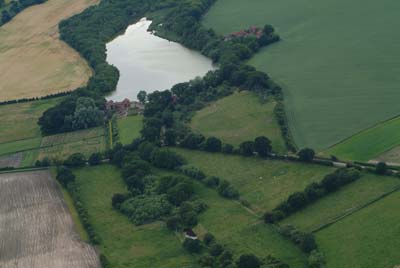 |
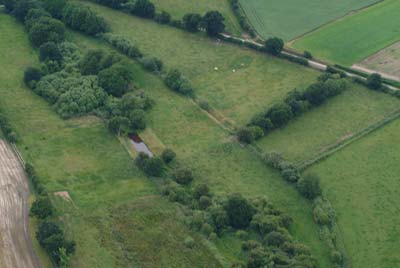 |
|
Antingham
Lower site in foreground and Antingham Upper
at the foot of the pond 30th June 2004 |
Antingham
Lower site after sinking of new North Sea gas main 30th June 2004 |
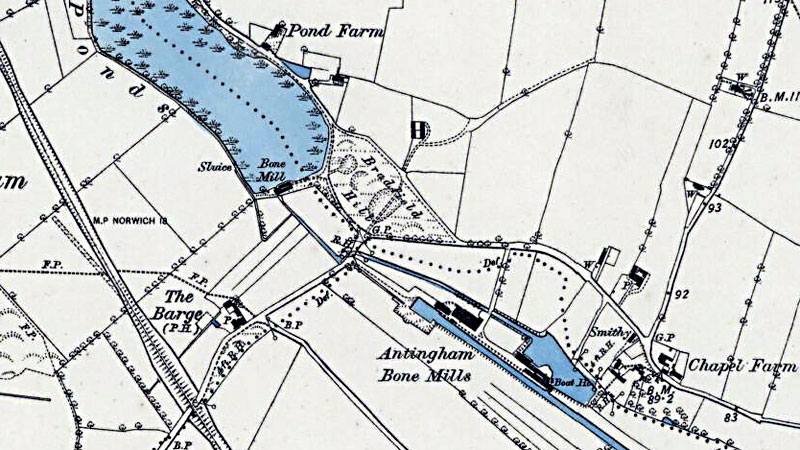 |
O. S. Map 1885 |
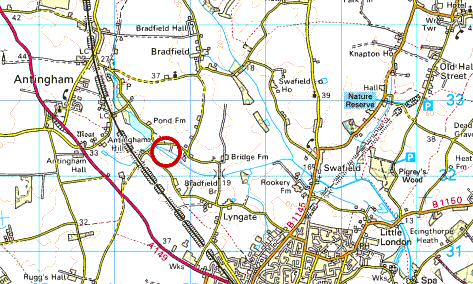 |
O.S. Map 2005 Image reproduced under licence from Ordnance Survey |
|
1257: Chamberlain of St. Benet's Abbey held Antingham with a Mill
Kelly's 1892: Mrs Charlotte Horsfield, bone crusher Kelly's 1896:
Edward Darby Horsfield, farmer, bone crusher and artificial manure manufacturer
Kelly's 1922: Edward Darby Horsfield, bone crusher
|
If you have any memories, anecdotes or photos please let us know and we may be able to use them to update the site. By all means telephone 07836 675369 or
|
| Nat Grid Ref TG 26703326 | Copyright © Jonathan Neville 2004 |